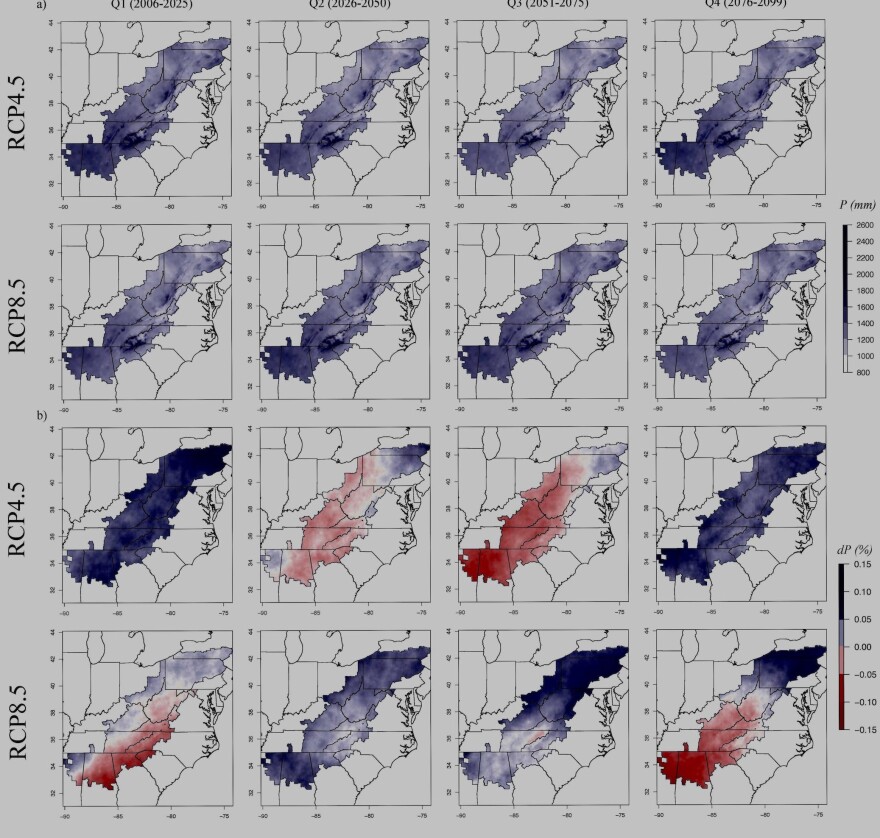The vast region that comprises Appalachia is known for its abundance of water. High mountain ridges here function like ‘water towers’ holding moisture from the atmosphere and sending it down into rivers, streams and aquifers, ultimately quenching the thirst of millions of people beyond its borders. But a new study finds that climate change could have a strange and devastating effect on this ancient system.
There would be both more floods and more droughts, escalating ecological and economic disruption.
A new climate projection by hydrologists at West Virginia University warns that Appalachia could become as much as 10 degrees hotter by mid-century. Working with other universities and a worldwide climate matrix, known as MACA they created scenarios for what the 420 counties that comprise the region could look like weather-wise.
Nicolas Zegre is director of the Mountain Hydrology Laboratory at WVU. “One of the things we were interested in, was creating science driven information that citizens could use, businesses could use, lawmakers could use, to understand how climate change is projected to impact them (due to) climate change in the Appalachian region, as part of our public discourse and our decision making.”
If nothing is done to mitigate temperature rise, the study says, Appalachia is likely to become not only hotter, but wetter and drier. How can it be both? Zegre, an associate professor of forest hydrology in the Davis College of Agriculture, Natural Resources and Design and his team, just completed a study of the entire 7 state region. Here’s how they say it would happen: “As the atmosphere warms, evaporation increases so water that is in the trees, in the soil, in our crops, in wetlands lakes and rivers, evaporates more quickly.” And with all that water held in the atmosphere, when it rains it pours. “In the steep topography of the Appalachian region, what this translates to, is landslides and floods.”
Zegre says, the flip side of that increased evaporation from those higher temperatures, means there’s less water in the landscape for crops, animals and humans to use. “So yes, we are expecting both too much water and too little water in the future and you can imagine how difficult that makes it to run businesses or governments, schools, hospitals, in communities with that kind of variability, where some times in the year it will be too wet to handle and other times too dry.”
The study mapped the entire Appalachian region, creating grids showing potential effects in each 2-mile section. Overall, with a rise in temperature to what’s projected to be anywhere from 5 to 10 degrees Fahrenheit, northern areas of Appalachia will become wetter and southern zones will become drier by 2050 if nothing is done. Zegre describes two scenarios; a best case ‘stabilization’ of climate model called RCP45 and “what we call the worse cast scenario, the RCP85 model, and unfortunately, the RCP85 represents how we are moving into the future, based on our current configuration in the global economy. Under the high emissions system, which represents business as usual, we actually see an increase in precipitation throughout the 21st century” for the region as a whole.
Now, the good news: “Following 2050, under the ‘stabilization scenario,’ we actually see the climate system return to historical conditions.” Studies like this already exist for other regions of the country. Zegre says this project aimed to fill the gap, saying, “the region has been understudied.”
Funded by a National Science Foundation grant, the team includes West Virginia State University and Marshall University. Zegre did his undergraduate work at Virginia Tech. He is also a veteran of the US army, “so my perspective on water is based on how changes in water resources impact our operations. The Department of Defense spends a lot of time examining these ‘threat multipliers;’ things that exacerbate unstable systems.” His perspective is, drought, and its close cousin, food insecurity, is driving human migration. He points out that the crisis in Syria began after a prolonged drought in that country. “Refugees in (Central America) are leaving, many due to a collapsed food system and limited opportunities."
This study points out, similar climate crises, extreme weather and increased droughts are already well underway. “Climate change used to be a 100 years away, hard for the human brain to understand,” says Zegre. “But, as we open our eyes and use our bodies, (the ultimate sensors) we see that climate change is now.” These intense floods and droughts are already causing disruptions of our economic system, “so that’s the critical thing about our study and others around the globe; Climate change is exacerbating situations by introducing more variability in our water systems, which makes it harder to manage any single event.”
The team will soon release a searchable data set where anyone can click to see what the future may hold for their communities. We will add a link to the site as soon as it is published.
This report, provided by Virginia Public Radio, was made possible with support from the Virginia Education Association.


